The following notes were written before excavation had started. We now know that there were no built structures at Ponthendre for Geophysics to detect, while on Castle Green any useful results were obscured by an overlay of dumped material.
While we were applying for our Heritage Lottery Fund grant in 2015, we were also liaising with English Heritage (now Historic England) who generously offered the project funding to carry out a geophysical survey at Ponthendre, on Castle Green and within the outer bailey of Longtown Castle.
We prepared a specification and then invited competitive tenders, which resulted in the contract being awarded to Stratascan Ltd of Upton upon Severn, Worcestershire.
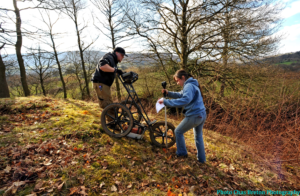
operating the ground penetrating radar
Geophysics uses a number of scientific techniques to search for buried archaeological features without digging them up. Three different methods of survey were proposed for the project: –
1) Resistivity
This measures variations in the electrical resistance of the ground. For example, a buried wall will have a high resistance while a filled-in but damp ditch will have a low resistance.
2) Gradiometry
Gradiometry can measure the tiny variations in the earth’s magnetic field caused by human activity. It is very good at locating areas of burning such as hearths or metal working sites and can in some circumstances detect walls and ditches.
3) Ground penetrating radar
GPR directs a pulse of radar into the ground and records the reflections from buried objects. In the right circumstances, a transect across a site can give a three dimensional picture of any structures below the ground.
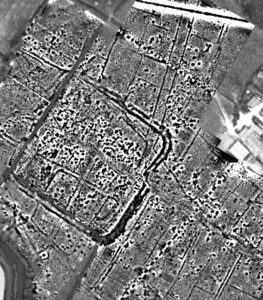
Gradiometry at East Sussex
Geophysics sometimes provides fantastic indications of buried archaeology, particularly when there are the remains of stone or brick buildings not far below the surface. Complete layouts of Roman towns have been plotted and we would have been thrilled if our geophysics produced results like this image of a previously unknown Roman settlement in East Sussex.
On the other hand the remains of wooden building from the Saxon or early Norman period are much more difficult to detect. If the variations in resistance and magnetic field are not present then geophysics can’t provide much information. For example if a wall has been robbed out for its stone or if a trench has been backfilled with the surrounding soil it’s unlikely to be detected by any geophysical technique.
Ponthendre
We have to say that the results of the geophysical survey were disappointing. At Ponthendre the resistivity showed no more than is visible on the surface of the ground. The gradiometry results were similar but showed a lot of “spikes”, normally indicating buried iron objects near to the surface. In this location they are probably horseshoes and debris from farm machinery.
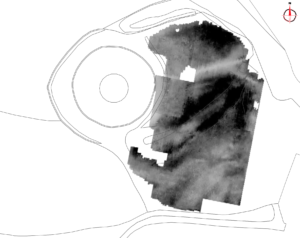
Ponthendre resistivity
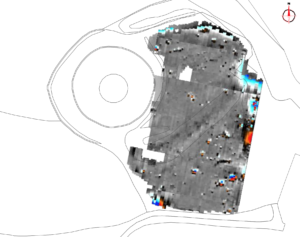
Ponthendre gradiometry
Surprisingly, the ground penetrating radar at Ponthendre failed to show any structural details of a tower but it did produce two interesting responses, in the centre of the motte and on the mound at the south-east end of the bailey. It isn’t clear what these objects are and they will be investigated by excavation.
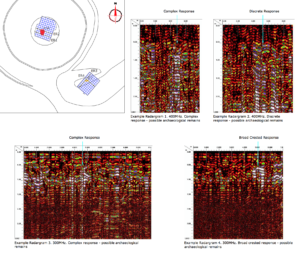
Ponthendre ground penetrating radar
Longtown castle
The geophysics on Castle Green suggests that Longtown was probably not a Roman settlement. The archaeology is more subtle. It is obvious from all the lumps and bumps that in the past the Green has seen a lot of dumping, probably from when the castle was erected, when the road was put through and when the old school was built. This dumping has masked any signals that might have come from the archaeology underneath. The pictures below show the resistivity and gradiometry signals which were obtained from the green and a section of the outer bailey of the walled castle for comparison.
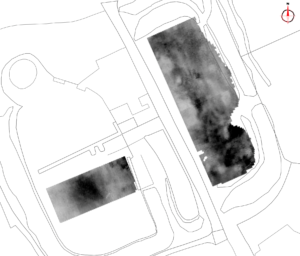
Longtown resistivity

Longtown castle gradiometry
In conclusion, the geophysics has unfortunately not provided us with much new information. However, it is clear from the quality of the earthworks that Ponthendre and Longtown castle are both archaeologically important and there is a good case for excavation.
